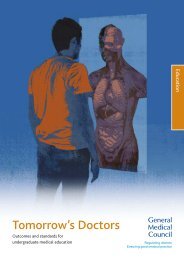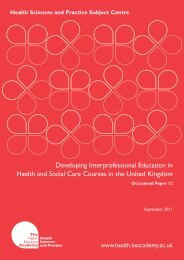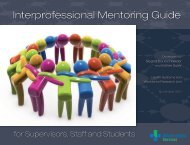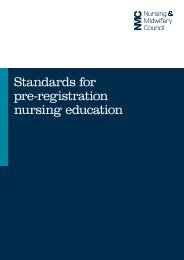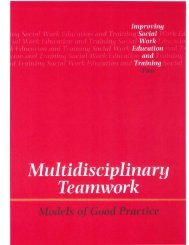(WHO) Patient Safety Curriculum Guide - CAIPE
(WHO) Patient Safety Curriculum Guide - CAIPE
(WHO) Patient Safety Curriculum Guide - CAIPE
You also want an ePaper? Increase the reach of your titles
YUMPU automatically turns print PDFs into web optimized ePapers that Google loves.
topic. Many of the topics are best delivered once<br />
the student has experienced their professional<br />
work environment as so much of patient safety<br />
learning requires a team approach and observation<br />
of the health service as a whole, not just the area<br />
where the student happens to be placed.<br />
The topics have been designed so that students<br />
can be responsible for much of their own learning<br />
through reading online material that provides<br />
them with the underpinning knowledge required,<br />
followed by tasks that can be performed to put<br />
the acquired knowledge into practice.<br />
We encourage the different faculties and health<br />
professions to add relevant professional literature<br />
and data to the topics that directly concern their<br />
profession. For example, we would expect that<br />
relevant pharmacy articles and data collections be<br />
included for pharmacy students. Because this<br />
is a Multi-professional <strong>Curriculum</strong> <strong>Guide</strong> we were<br />
unable to provide examples for all professions,<br />
but we have included as many as possible where<br />
available and relevant.<br />
What is the <strong>Curriculum</strong> <strong>Guide</strong>?<br />
The <strong>Curriculum</strong> <strong>Guide</strong> is a comprehensive<br />
programme for the implementation of patient<br />
safety education in health-care educational<br />
institutions worldwide. It comprises two parts.<br />
Part A is a teacher’s guide, which has been<br />
designed to assist teachers to implement the<br />
<strong>Curriculum</strong> <strong>Guide</strong>. As we are aware that patient<br />
safety is a new discipline and many health-care<br />
professionals and faculty staff will be unfamiliar<br />
with many of the concepts and principles, this<br />
part lays the foundations for capacity-building<br />
in patient safety education. Part B provides<br />
a comprehensive, ready-to-teach, topic-based<br />
patient safety programme that can be implemented<br />
either as a whole or on a per topic basis.<br />
Why was the <strong>Curriculum</strong> <strong>Guide</strong><br />
developed?<br />
Since the Harvard study [1] in 1991 first described<br />
the extent of harm to patients, other countries<br />
have reported similar results, notwithstanding<br />
the differences in their cultures and health<br />
systems. The realization that health care actually<br />
harms patients has increased scrutiny of patient<br />
care in the context of an increasingly complex<br />
health system. This complexity has been<br />
intensified by rapidly changing medical technology<br />
and service demands [2,3]. Doctors, nurses,<br />
midwives, dentists, pharmacists, and other<br />
health-care professionals are expected to manage<br />
this complexity in their daily work, provide<br />
evidence-based health-care services, and maintain<br />
a safe environment for patients. However, unless<br />
they are properly educated and trained in patient<br />
safety concepts and principles they will struggle<br />
to do this.<br />
<strong>Patient</strong> safety education for health-care<br />
professionals in the higher education sector has<br />
not kept up with workforce requirements [3-7]. For<br />
example, incident reporting systems for medication<br />
errors or surgical mistakes have been in use for<br />
many years in several countries, but accounts<br />
of specific curricula related to health-care errors or<br />
patient safety courses embedded in undergraduate<br />
education have started to be described only<br />
recently in the published literature [5,8].<br />
A number of factors have impeded patient safety<br />
education. First, the lack of recognition by<br />
health-care educators that teaching and learning<br />
patient safety should be an essential part of the<br />
undergraduate curricula for health-care students,<br />
and that patient safety skills can be taught [9,10].<br />
Many educators are unfamiliar with the literature<br />
and are unsure how to integrate patient safety<br />
learning into existing curricula [11,12]. Second,<br />
educators need to be open to new areas of<br />
knowledge [3]. One of the difficulties in<br />
introducing new curricula is a reluctance to address<br />
knowledge that originates from outside one’s<br />
profession, such as systems thinking and qualityimprovement<br />
methods [10]. It has also been<br />
suggested that the historical emphasis on<br />
treatment of disease rather than prevention of<br />
illness creates a culture that finds it difficult to give<br />
merit to a “non-event”, i.e. a preventable adverse<br />
event [3]. A third factor relates to entrenched<br />
attitudes regarding the traditional teacher-student<br />
relationship- one that may be hierarchical<br />
and competitive [9] and where an “expert”<br />
disseminates information to the student [3,4].<br />
This <strong>Curriculum</strong> <strong>Guide</strong> seeks to fill the gap<br />
in patient safety education by providing<br />
a comprehensive curriculum designed to build<br />
foundation knowledge and skills for all health-care<br />
students that will better prepare them for clinical<br />
practice in a range of environments.<br />
References<br />
1. Brennan TA et al. Incidence of adverse events<br />
and negligence in hospitalized patients: results<br />
of the Harvard Medical Practice Study I. New<br />
England Journal of Medicine, 1991, 324:370–376.<br />
2. Runciman B, Merry A, Walton M. <strong>Safety</strong> and<br />
ethics in healthcare: a guide to getting it right, 1st ed.<br />
Aldershot, UK, Ashgate Publishing Ltd, 2007.<br />
3. Stevens D. Finding safety in medical education.<br />
Quality & <strong>Safety</strong> in Health Care, 2002,11:109–110.<br />
23 Part A 1. Background




